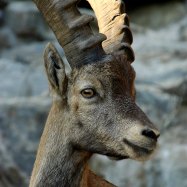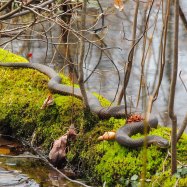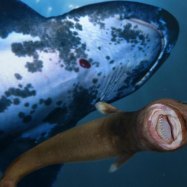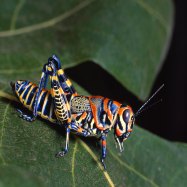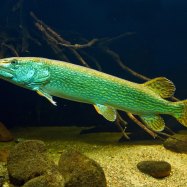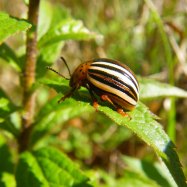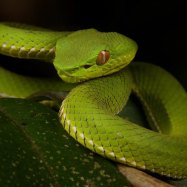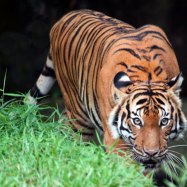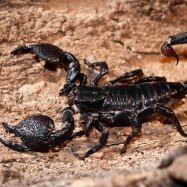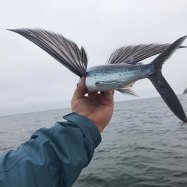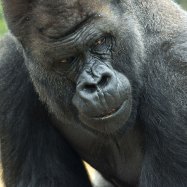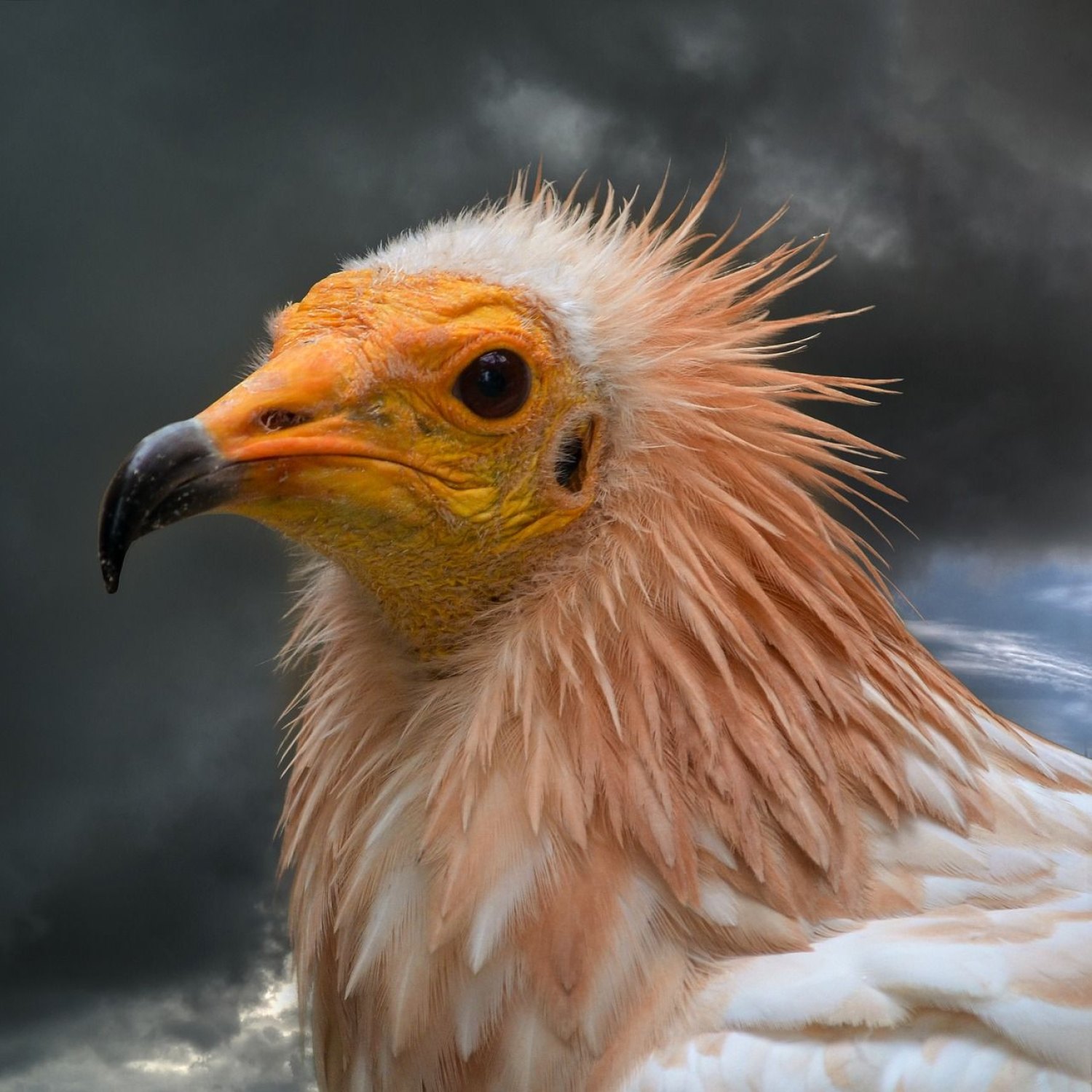
Egyptian Vulture
60-70 cm
The Egyptian Vulture is a magnificent bird found in Africa, Europe, and Asia. With a length of 60-70 cm, it belongs to the Accipitridae family and has a medium-sized body, long wings, and a distinctive wedge-shaped tail. Keep an eye out for this stunning creature while exploring these regions!
Animal Details Summary:
Common Name: Egyptian Vulture
Kingdom: Animalia
Habitat: Deserts, savannas, grasslands, mountains
The Magnificent Egyptian Vulture: A Stunning Bird of Prey
The desert sun beats down on the hot, arid landscape of Egypt. As the scorching sand shimmers in the heat, a majestic bird soars through the sky, casting its shadow upon the ancient land. Its white plumage catches the light, and its distinctive yellow face and black feathers on its wings and tail make it easily recognizable – it's the Egyptian Vulture.Scientifically known as Neophron percnopterus, the Egyptian Vulture is a remarkable bird of prey that has captured the hearts and imaginations of many cultures for centuries Egyptian Vulture. Also known as Pharaoh's Chicken or the White Scavenger Vulture, this bird is an essential part of their ecosystem, playing a crucial role in keeping the natural balance.
In this article, we will delve into the world of the Egyptian Vulture, exploring its habitat, diet, geographic distribution, physical characteristics, and more. Join us on this journey of discovery as we learn about this remarkable creature of the skies.
A Classification of Perfection
Before we dive into the world of the Egyptian Vulture, let's first understand its classification. As with all living beings, this majestic bird has its place in the natural order of things, as defined by biological classification.The Egyptian Vulture is a member of the animal kingdom, class Aves – the class of birds. It belongs to the order of Accipitriformes and the family Accipitridae, which includes hawks, eagles, and kites. Its scientific name, Neophron percnopterus, comes from the Greek words "neos" meaning new, and "phronima" meaning a vulture.
This impressive bird may not be the largest of its kind, but its uniqueness makes it stand out among the rest Eastern Racer. Its scientific name accurately describes this rarity – a "new vulture" in the evolutionary sense, with its distinctive features and behaviors.
Home is Where the Heart Is
The Egyptian Vulture is a highly adaptable bird, known for its vast geographic range. Its natural habitat includes deserts, savannas, grasslands, and mountains, making it a diverse species that can thrive in different environments.However, this range is predominantly found in Europe, Africa, and Asia, with Egypt being its country of origin. But, despite its name, the Egyptian Vulture is not only found in Egypt. It can be seen in a multitude of places within its geographic range, making it a truly global species.
A Unique Feeding Method
The Egyptian Vulture's diet is far from typical, compared to other birds of prey. Unlike its relatives, it is not a hunter – it's a scavenger. Its primary source of food is carrion, meaning that it feeds on the dead carcasses of other animals.While this may seem like a gruesome habit, the Egyptian Vulture plays a crucial role in the ecosystem. It helps control the spread of diseases by consuming carcasses that could otherwise become breeding grounds for bacteria and viruses. Its presence also reduces the competition for food, allowing other carnivorous animals to hunt for fresh prey.
However, these birds are also known to steal food from other birds, such as smaller vultures and storks. This behavior is not unique to the Egyptian Vulture, as it is observed in other bird species as well. It's a survival instinct that ensures their survival in harsh conditions.
The Beauty of the Beast
While scavenging may not be the most elegant of feeding methods, the Egyptian Vulture more than makes up for it with its stunning appearance. This medium-sized bird has a thin body, long wings, and a distinctive long, wedge-shaped tail.The Egyptian Vulture's white plumage is its most striking feature, making it easily recognizable in flight. Its feathers also have a soft, down-like texture, allowing them to glide effortlessly in the air. This plumage also provides excellent insulation against the intense heat of its desert homeland.
But it's not just the white plumage that makes the Egyptian Vulture stand out. Its face and head are a bright yellow, almost like a sunburst, giving it a striking appearance. Its wings and tail have striking black feathers, adding to its unique beauty.
The Vital Statistics
Measuring between 60-70 cm in length and weighing between 1.8-2.6 kg, the Egyptian Vulture is not the largest bird of prey. However, its size is deceptive, as its wingspan can reach up to 1.6 meters, allowing it to soar high in the sky.The average lifespan of the Egyptian Vulture is between 20-30 years, but in captivity, they have been known to live up to 40 years. This impressive lifespan makes the Egyptian Vulture one of the longest-lived birds of prey.
A Disappearing Species
While the Egyptian Vulture may be thriving in its natural habitat, it is considered an endangered species. Due to factors such as habitat loss, deliberate poisoning, and collisions with power lines, the populations of these birds are on the decline.In some countries, the killing of these birds is even considered a cultural practice. In the past, it was believed that the blood of the Egyptian Vulture could cure a person of various ailments. This belief has led to the decline of these birds in certain areas, as they are hunted for their blood.
With measures in place to protect this species, such as captive breeding programs, the Egyptian Vulture's population is slowly recovering. However, more significant efforts are needed to ensure the survival of this magnificent bird for future generations.
A Symbol of Ancient Egypt
The Egyptian Vulture has long been a part of ancient Egyptian culture and symbolism. Its striking appearance and behaviors have captured the imaginations of these ancient civilizations, leading to their inclusion in art and legends.In ancient Egypt, the Egyptian Vulture was associated with the goddess Nekhbet, the goddess of protection, maternity, and childbirth. She was often depicted with an Egyptian Vulture head or wearing a vulture crown, representing the goddess's nurturing and protective nature.
The Egyptian Vulture's image has also been found on ancient hieroglyphs, pottery, and other artifacts, showing its significance in ancient Egyptian life and beliefs. This cultural connection has helped to preserve the importance of the Egyptian Vulture throughout history.
The Modern-Day Egyptian Vulture
Today, the Egyptian Vulture continues to hold a place in modern society, with its symbol used in various emblems, flags, and coats of arms. In Spain, it is the national bird, and in Albania, it is part of the country's national emblem.In popular culture, the Egyptian Vulture has also made appearances, most notably in the animated film "The Lion King," as a character named Zazu. Its striking appearance and unique behaviors have also made it a popular bird for birdwatchers and nature enthusiasts, drawing tourists to areas where they can be found.
An Important Piece of the Puzzle
In conclusion, the Egyptian Vulture is more than just a bird of prey. It is a vital piece of the ecosystem, playing a crucial role in maintaining the balance of nature. Its stunning appearance and its cultural significance make it a unique and extraordinary creature that continues to fascinate and intrigue people around the world.As we continue to learn more about this magnificent bird, we must also take steps to protect its future. Their declining populations are a reminder of the fragility of our planet's ecosystems and the importance of preserving them for the creatures that call it home. Let us all admire the beauty and wonder of the Egyptian Vulture and work together to ensure its survival for generations to come.

Egyptian Vulture
Animal Details Egyptian Vulture - Scientific Name: Neophron percnopterus
- Category: Animals E
- Scientific Name: Neophron percnopterus
- Common Name: Egyptian Vulture
- Kingdom: Animalia
- Phylum: Chordata
- Class: Aves
- Order: Accipitriformes
- Family: Accipitridae
- Habitat: Deserts, savannas, grasslands, mountains
- Feeding Method: Carrion feeder
- Geographical Distribution: Europe, Africa, and Asia
- Country of Origin: Egypt
- Location: Africa, Europe, Asia
- Animal Coloration: White plumage with a yellow face and black feathers on their wings and tail
- Body Shape: Medium-sized bird with a thin body, long wings, and a long, wedge-shaped tail
- Length: 60-70 cm
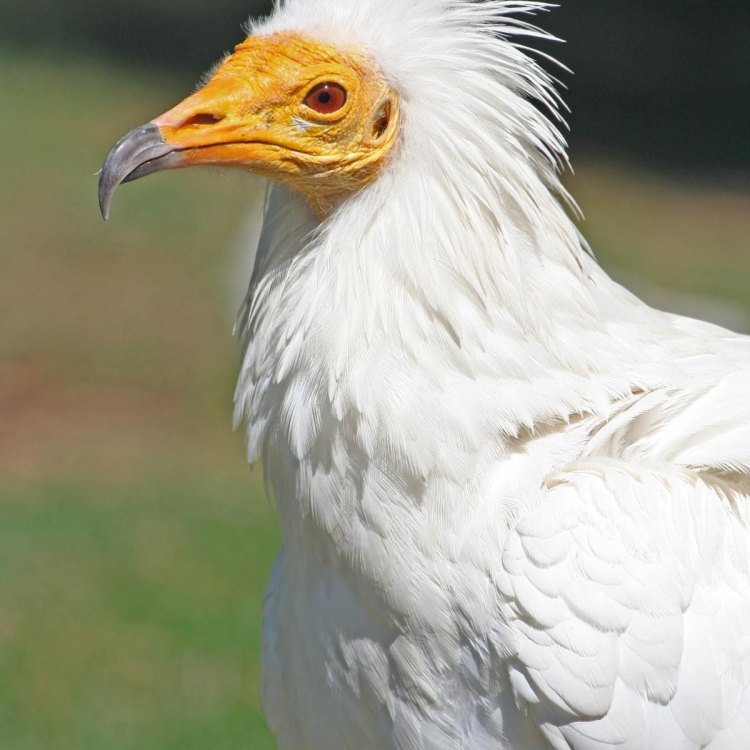
Egyptian Vulture
- Adult Size: Large bird with a wingspan of 165-185 cm
- Average Lifespan: Up to 30 years
- Reproduction: Sexual reproduction
- Reproductive Behavior: Monogamous
- Sound or Call: High-pitched whistles and hissing calls
- Migration Pattern: Partially migratory with some populations migrating long distances
- Social Groups: Solitary or in small groups
- Behavior: Scavenger, often feeding in groups around large carcasses
- Threats: Habitat loss, poisoning, collision with power lines, and illegal hunting
- Conservation Status: Endangered
- Impact on Ecosystem: Key scavengers that play an important role in cleaning up carrion and preventing the spread of diseases
- Human Use: Used in traditional medicine and cultural practices
- Distinctive Features: Yellow face and black feathers on wings and tail
- Interesting Facts: They have been known to use rocks as tools to break open ostrich eggs
- Predator: Larger birds of prey and mammals
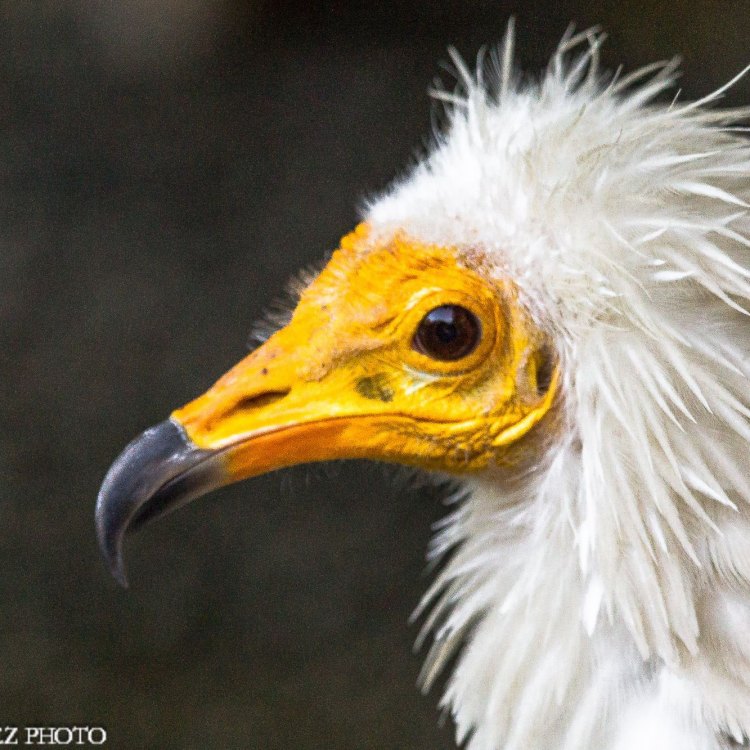
Neophron percnopterus
The Mighty Egyptian Vulture: A Unique Bird in Danger
In the vast and diverse world of birds, there is one species that stands out with its distinctive features and behaviors – the Egyptian Vulture. This large bird, with a wingspan of 165-185 cm, belongs to the family of Accipitridae, and can be found mainly in southern Europe, Asia, and parts of Africa. But what makes this bird so unique and why is it in danger? In this article, we will delve into the intriguing world of the Egyptian Vulture, and explore the factors that contribute to its endangered status.At first glance, the Egyptian Vulture may appear to be just another bird of prey, but upon closer observation, its striking yellow face and black feathers on its wings and tail immediately catch the eye PeaceOfAnimals.Com. In fact, its appearance has earned it various names, such as the "Pharaoh's Chicken" or "King of Vultures." But what truly sets this bird apart is not just its physical appearance, but its behavior and unique traits that have fascinated researchers and bird enthusiasts for centuries.
One of the most interesting aspects of the Egyptian Vulture's behavior is its reproductive pattern, which follows sexual reproduction. Unlike many birds that reproduce asexually, the Egyptian Vulture mates with a partner of the opposite sex, and both parents take part in raising their offspring. They are also known to be monogamous, meaning they mate with only one partner for life. This kind of reproductive behavior is rare in the animal kingdom and adds to the mystique of this magnificent bird.
Another striking characteristic of the Egyptian Vulture is their vocalizations, or lack thereof. While many birds are known for their melodious songs, the Egyptian Vulture's sound or call is mainly composed of high-pitched whistles and hissing calls. These sounds are often used to communicate with their mates and offspring, as well as to defend their territory Estrela Mountain Dog.
But perhaps one of the most astonishing features of the Egyptian Vulture is its intelligence and resourcefulness. This bird has been observed using rocks as tools to break open ostrich eggs, an impressive display of problem-solving skills. This behavior has been documented in various populations and is a testament to the adaptability and ingenuity of this species.
When it comes to their social behavior, Egyptian Vultures can be found either solitary or in small groups. They are mainly scavengers and often feed in groups around large carcasses, showing a preference for fresh meat. This social behavior is also a protective measure against predators, as larger groups can watch out for potential dangers and share food resources.
Unlike many bird species that are strictly migratory or sedentary, the Egyptian Vulture falls somewhere in between. They are considered partially migratory, with some populations migrating long distances, while others remain in their natural habitat year-round. Migrations mostly occur in response to changes in food availability, and these patterns vary depending on the region and population.
But despite its robust size and impressive behaviors, the Egyptian Vulture is facing numerous threats to its survival. The International Union for Conservation of Nature (IUCN) has listed the species as endangered, with a declining population trend. One of the main threats to their existence is habitat loss, as their natural habitats are being destroyed due to human activities such as agriculture, mining, and urbanization.
In addition to habitat loss, Egyptian Vultures are also facing threats from poisoning, collision with power lines, and illegal hunting. These activities are often carried out by humans, either intentionally or unintentionally, and have severe consequences for the vultures and their habitats. For example, poisoning, which is often used as a means of controlling pests or predators, can also harm vultures when they consume poisoned carcasses.
The impact of these threats has a cascading effect on the entire ecosystem. As key scavengers, Egyptian Vultures play a crucial role in the environment by cleaning up carrion and preventing the spread of diseases. Without them, the carcasses of dead animals would accumulate, leading to an increase in disease transmission and a disturbance in the delicate balance of the ecosystem.
Despite their ecological importance, Egyptian Vultures have also been affected by human activities in another way – through human use. This magnificent bird has been used by humans for centuries in traditional medicine and cultural practices. Its body parts are believed to have healing properties, and some cultures use it in rituals and ceremonies. Although this practice has decreased in recent years, it still poses a threat to the already dwindling population of the Egyptian Vulture.
But all is not lost for this magnificent bird. The Egyptian Vulture is listed under various conservation programs and is protected by laws in many countries. Some efforts are being made to conserve their habitats, raise awareness about their importance, and mitigate the threats they face. For example, the "Vultures of Ancient Egypt" project aims to protect the Egyptian Vulture in its breeding sites in the Balkans and raise awareness about this species through education and community involvement.
It is also essential for individuals to play their part in the conservation of these birds. Simple actions such as not using pesticides and supporting conservation organizations can make a significant difference in preserving the Egyptian Vulture and its habitat.
In conclusion, the Egyptian Vulture is a unique and fascinating bird that is facing numerous threats to its survival. Its distinctive features, behaviors, and intelligence make it a valuable species in the animal kingdom, yet it is in danger of extinction. It is crucial for us to take action to protect this bird and its habitat, not only for its own sake but also for the balance of our ecosystem. By understanding and appreciating the Egyptian Vulture, we can work towards securing its future and preserving its place as the "King of Vultures."
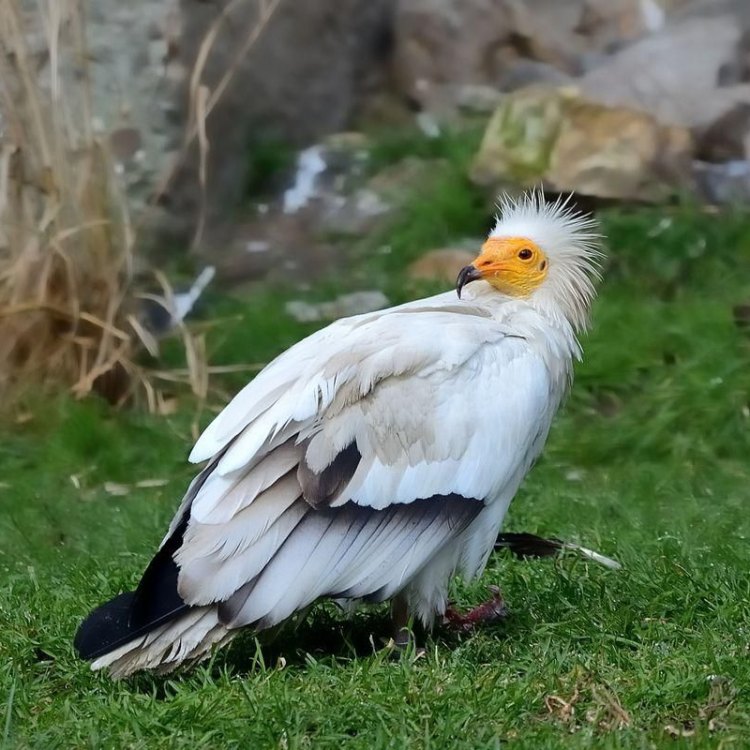
The Magnificent Egyptian Vulture: A Stunning Bird of Prey
Disclaimer: The content provided is for informational purposes only. We cannot guarantee the accuracy of the information on this page 100%. All information provided here may change without prior notice.

